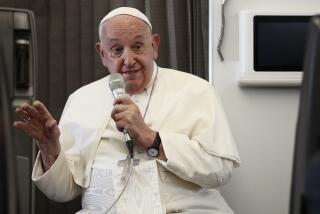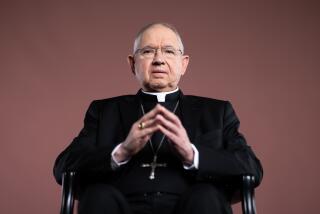Pope Stresses Varied Themes as He Moves Up the Coast
Pope John Paul II, moving up the California coast Thursday to Monterey and San Francisco, urged growers to accept farm workers’ rights to unionize, comforted AIDS patients and encouraged nuns, monks and religious-order priests to remain faithful to their traditional ascetic vows.
After flying out of Los Angeles on the eighth day of his 10-day pastoral visit to United States, the Pope conducted Mass at the Laguna Seca Raceway in Monterey. Speaking from a platform made of hundreds of vegetable crates, John Paul delivered a paean to the dignity of work, and agricultural work in particular.
He appealed to “landowners, growers and others in positions of power to respect the just claims of their brothers and sisters who work the land.”
“These claims include the right to share in decisions concerning their services and the right to free association with a view to social, cultural and economic advancement,” the pontiff told a smaller than expected crowd of 50,000.
The Catholic Church has long backed the United Farm Workers union in the Salinas Valley.
The Pope spoke of the richness of American agriculture, “a major success story.” But he also noted with sadness “that recently thousands of American farmers have been introduced to poverty and indebtedness. Many have lost their homes and their way of life. . . . On an even wider scale is heard the voice of the poor, who are bewildered in a land of plenty and still experience the pangs of hunger.”
His audience--far smaller than the 100,000 predicted by some church officials--sat on a hillside divided by thousands of potted red petunias that cut a swathto the hill’s top, where a 150-foot-high metal scaffolding cross was covered with white fabric.
Doris Consier, a 54-year-old single woman and Salinas house cleaner, said she attended because she is struggling. “Things are getting worse and worse,” she said. “Hard work. No benefits. I came here because I needed something. When you’re all by yourself you need someone and all the good men are taken. So I needed the feeling, the feeling of religion. I need that right now. I brought a rug to sit on, a blanket to wrap in, some food to eat, some juice to drink. And I brought my spirit. I feel closer to God than I ever have before.”
The Pope’s homily was delivered in English, even though many in the audience spoke only Spanish. Still, the pontiff’s presence seemed to be enough for some. “What we don’t understand we hear in our hearts,” Jesus Correa, a 48-year-old farm worker, said in Spanish.
After the Mass the Pope traveled to the mission at nearby Carmel, where he praised Father Junipero Serra, the Franciscan who founded the California missions. A longstanding campaign to have Serra beatified, the penultimate step to sainthood, remained incomplete when the pontiff began his current U.S. pilgrimage, disappointing local Catholics who had hoped the beatification would take place here Thursday.
Serra is a controversial figure whose critics contend that he and other Franciscans whipped and otherwise mistreated Indians and crushed the native culture.
As he did in Phoenix on Monday at a gathering of Catholic Indians, the Pope defended Serra’s record.
Less than a mile from the mission--the closest that law enforcement officials would permit them--about 150 Indians and their supporters gathered “to tell the world of the brutality that existed against our people in the missions of California,” according to spokesman Anthony Miranda, tribal chairman of the Coastanoan Band of Carmel Mission Indians.
The Pope then left for San Francisco, where he viewed the Golden Gate Bridge and rode in a 1.8-mile motorcade that attracted a crowd estimated by police at 25,000. Officials had predicted 1.3 million.
Also in evidence were an estimated 8,000 demonstrators--by far the greatest mass of protesters of John Paul’s visit.
San Francisco’s official welcoming ceremony at the Mission Dolores basilica provided the most dramatic moments of the day, as the pontiff shook hands with several AIDS patients and gave them his blessing. He hugged tightly to his chest 4-year-old Brendan O’Rourke of San Francisco, who contracted AIDS from a blood transfusion.
“God loves you all, without distinction, without limit,” John Paul said.
The protest took on an only-in-San Francisco flavor. Strident and bitter statements from feminists and gays were tempered with biting humor and street theater.
Lisa, a self-described “recovering Catholic,” wore a mock maternity dress, carried three baby dolls and had written on an apron the words: “My uterus, property of the Vatican.”
Although merchants in the area had protected their plate-glass windows with plywood for fear of trouble, the demonstration remained peaceful.
Later, in a meeting with Roman Catholic sisters, brothers and religious order priests, John Paul told them not to be discouraged by their numbers. New members will be found to fill the void if the church’s traditional ascetic vows are followed, he said.
“Your joyful witness to consecrated love--in chastity, poverty and obedience--will be the greatest human attraction for young people to religious life in the future,” the Pope told the 3,000 enthusiastic religious workers assembled in the high-vaulted sanctuary of St. Mary’s Cathedral, in his last appearance of the day.
But he acknowledged that the drastic declines in religious vocations during the last 20 years presented “serious challenges” to the church and its religious orders.
The Pope was responding to talks by Sister Helen M. Garvey, president of the Sisters of Charity of the Blessed Virgin Mary and president-elect of the Leadership Conference of Women Religious, and Father Stephen Tutas, a member of the Conference of Major Superiors of Men Religious.
Tutas was chosen to speak for the U.S. Catholic Church’s male “religious”--8,500 brothers, and 22,000 priests who belong to religious orders, such as the Jesuits’ Society of Jesus.
Brothers, like order priests and nuns, take vows of chastity, poverty and obedience. Diocesan priests vow obedience and celibacy, but not poverty. Brothers can perform many of the same duties as priests, but they are prohibited from such functions as saying Mass and hearing confessions.
Garvey, speaking for the nation’s 113,000 nuns, asked the Pope how women could “participate completely in the life of the church”--a repetition of an implicit request made several times during the Pope’s U.S. visit that he consider allowing women to be ordained.
Noting that religious sisters labor under “very real limitations,” Garvey added, to resounding applause: “The church needs the fullness of women’s gifts and the strength of women’s commitment.”
But in his 40-minute response, the pontiff gave no indication that the traditional vows of religious orders would be relaxed, or women priests allowed.
In Monterey, traffic was snarled at Laguna Seca Raceway eight hours after the Mass had ended, and thousands of people remained, according to the Monterey County Sheriff’s Department.
When night fell and temperatures dropped, the Red Cross distributed blankets. Many had been at the raceway for more than 14 hours.
But by 11 p.m., officials reported that the traffic jam had cleared up and almost everyone had left.
Times staff writers Stephen Braun, David Freed and Ray Sanchez in Los Angeles, Russell Chandler, Eric Malnic and Louis Sahagun in Monterey, Mark I. Pinsky in Carmel and Dan Morain in San Francisco also contributed to this story.
More to Read
Sign up for Essential California
The most important California stories and recommendations in your inbox every morning.
You may occasionally receive promotional content from the Los Angeles Times.











